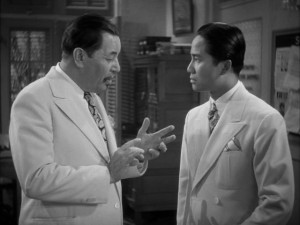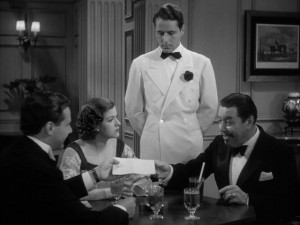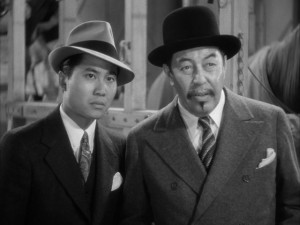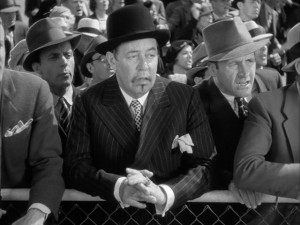
When the studio ran out of Earl Derr Biggers’ Charlie Chan novels to film, the solution was to place the character in new stories that invariably had him going to some colorful locale — and in this case, it was the race track. And while Charlie Chan at the Race Track (1936) may not be the best of the 44 movies that make up the whole series, it is so exactly the very definition of a Charlie Chan movie from the era when Warner Oland played the Chinese detective that it’s probably the most essential of them all. This slick, fast-moving B picture has absolutely everything that defines a Charlie Chan mystery. Plus — like all the films from the Oland era — the production values are so high that 20th Century Fox was actually a little annoyed because they looked better than many of their A pictures. The story this round finds Charlie investigating — with the help and hindrance of his No. One Son, Lee (Keye Luke) — the murder of an old friend, who just happens to have been in the horse-racing game. It was the first of three of the best-loved Warner Oland Charlie Chan pictures to be directed by H. Bruce Humberstone, who had a knack for getting the best out of the material, and he does so here.
By the time of Charlie Chan at the Race Track, Fox and Warner Oland had been making Charlie Chan pictures for five years. This, in fact, was the twelfth film in the series (four of the first five are considered to be lost), and the fourth film with Keye Luke as Charlie’s No. One Son, Lee. Luke’s character — an outgrowth of the Kashimo character (Charlie’s bumptious Japanese assistant in two of the books) — had been added to the mix in 1935 with Charlie Chan in Paris (which at one time was also considered lost). This gave Charlie someone to play off, and it also afforded him someone more suited to doing legwork than Charlie’s years and girth made entirely practical. It was a good teaming. Luke and Oland had terrific chemistry — both onscreen and off. To his dying day, Luke referred to Oland as “Pop,” just as his character had done.

There’s no denying that Lee is largely comedy relief. (He once lobbied to play the character a little more intelligently, but was told by the studio, “In every team, there’s a smart one and a dumb one — and you’re dumb one.” That settled that.) At the same time, there was an obvious love between Charlie and Lee — something that was never evidenced with any of Charlie’s later offspring. For that matter, there are scenes in their first two pairings — Paris and Charlie Chan in Shanghai (1935) — which Lee plays completely straight when he thinks his father’s been hurt. There’s a bit of that in Race Track where Lee expresses concern over the danger Charlie’s in. Even when Lee is at his most manic — as when he interrupts a lesson in forensics Charlie’s giving (“Train of thought now need wrecking crew!”) — there’s a noticeable warmth between the characters.

The screenplay by frequent Oland-era Chan scribes Robert Ellis, Helen Logan, and Edward T. Lowe is one of the better ones in the series. It’s very shrewdly constructed to link together Charlie’s opening dissertation on blood spatters (“Record indicate most murder result from violence, and murder without bloodstain like Amos without Andy — most unusual”) to his proving that the victim in the film could not have been kicked to death by a horse as the murderer would have us believe. The characters are nicely drawn and the film moves well, though cleverly keeping the race track setting to a minimum so that it works as the actual payoff it should be. And the Chan-o-grams — you know, those aphorisms that served to make the series a hit in the first place — are plentiful, pithy, and useful. After all, is there any better advice than, “Foolish rooster who stick head in lawnmower end in stew”?

As noted, the film marked the first of three Oland Chans to be directed by H. Bruce Humberstone, and while it’s unusual for directors on programmers like this to have much input into the writing of the films, there’s a peculiarity common to his three entries. In each of the films — this, Charlie Chan at the Opera (1936) and Charlie Chan at the Olympics (1937) — the story stops dead in its tracks for a kind of mini science lesson, albeit one in keeping with the mechanics of the story. Here, the film pauses to carefully explain just how the photo-finish cameras work. In Opera we get a detailed demonstration of how wirephotos are transmitted, and in Olympics we get a soon to be untimely explanation of the advantages of traveling by zepplin — the Hindenburg to be exact (no doubt Fox was not happy about this, since the airship met its end 15 days before the movie came out). I won’t say it exactly qualifies as a style (if Humberstone has a style, it’s speed and slickness), but it’s an interesting quirk.

It’s also worth noting that, though there’s no evidence of it onscreen, by this time Oland’s drinking had become fairly pronounced. Directors knew to work around the fact and get as many of his scenes as possible shot early in the day, though that was sometimes not possible, especially on location. Back in 1986 when I was working on my book, Charlie Chan at the Movies, Keye Luke and I were talking one afternoon and he related a story about one of the film’s race track scenes. By the time a key shot was to be taken Oland was in a state of pretty advanced inebriation, so Humberstone solved the problem by having Oland lean on the track railing, while the other players gathered in close around him so he couldn’t fall over. Since the scene required Charlie to spot a critical clue, Humberstone stood off to the side and once the scene was underway fired a prop gun, causing Oland to widen his eyes as if he’d seen something. Of such trickery movies are made, and as Keye Luke would have put it, “Well, that was Pop.”
The Asheville Film Society will screen Charlie Chan at the Race Track on Tuesday, March 27, at 8 p.m. in the Cinema Lounge of The Carolina Asheville and will be hosted by Xpress movie critics Ken Hanke and Justin Souther. Hanke is the artistic director of the A.F.S.




Before you comment
The comments section is here to provide a platform for civil dialogue on the issues we face together as a local community. Xpress is committed to offering this platform for all voices, but when the tone of the discussion gets nasty or strays off topic, we believe many people choose not to participate. Xpress editors are determined to moderate comments to ensure a constructive interchange is maintained. All comments judged not to be in keeping with the spirit of civil discourse will be removed and repeat violators will be banned. See here for our terms of service. Thank you for being part of this effort to promote respectful discussion.